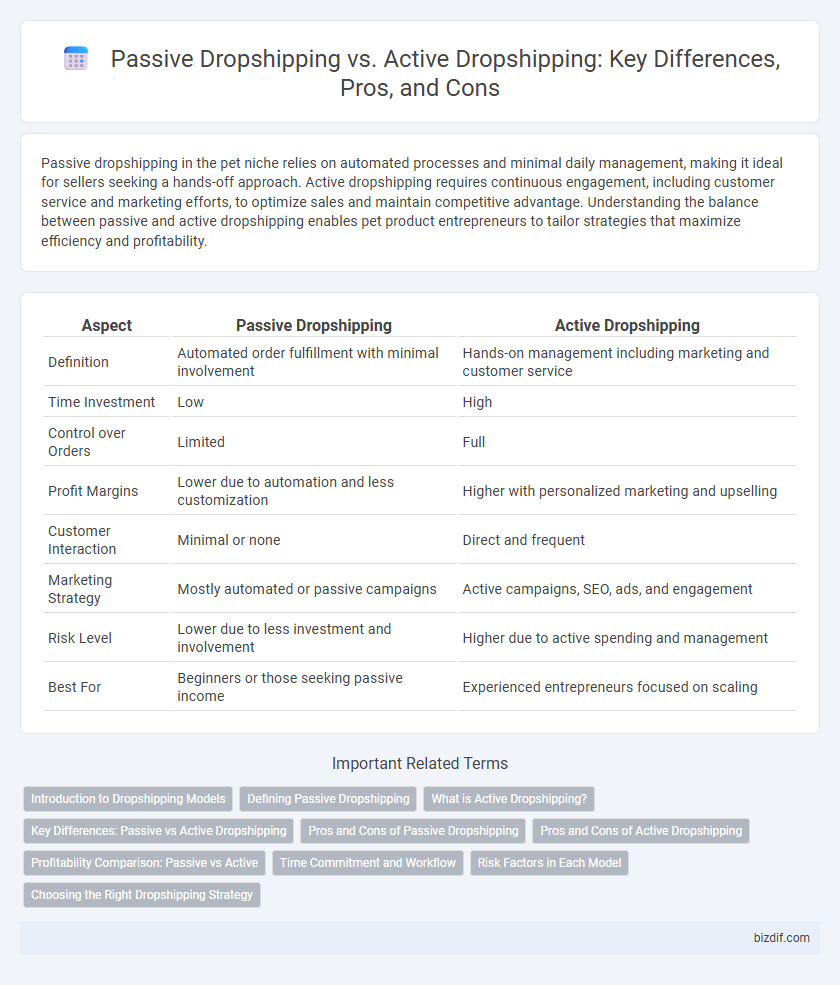Passive dropshipping in the pet niche relies on automated processes and minimal daily management, making it ideal for sellers seeking a hands-off approach. Active dropshipping requires continuous engagement, including customer service and marketing efforts, to optimize sales and maintain competitive advantage. Understanding the balance between passive and active dropshipping enables pet product entrepreneurs to tailor strategies that maximize efficiency and profitability.
Table of Comparison
| Aspect | Passive Dropshipping | Active Dropshipping |
|---|---|---|
| Definition | Automated order fulfillment with minimal involvement | Hands-on management including marketing and customer service |
| Time Investment | Low | High |
| Control over Orders | Limited | Full |
| Profit Margins | Lower due to automation and less customization | Higher with personalized marketing and upselling |
| Customer Interaction | Minimal or none | Direct and frequent |
| Marketing Strategy | Mostly automated or passive campaigns | Active campaigns, SEO, ads, and engagement |
| Risk Level | Lower due to less investment and involvement | Higher due to active spending and management |
| Best For | Beginners or those seeking passive income | Experienced entrepreneurs focused on scaling |
Introduction to Dropshipping Models
Passive dropshipping involves automating order fulfillment and customer service to minimize hands-on management, ideal for entrepreneurs seeking minimal daily involvement. Active dropshipping requires continuous engagement in marketing, supplier communication, and customer interactions to optimize sales and resolve issues promptly. Both models leverage third-party suppliers to handle inventory and shipping, differing primarily in the level of operational control and time commitment.
Defining Passive Dropshipping
Passive dropshipping involves automating order fulfillment and customer service processes, minimizing daily management and allowing sellers to focus on marketing and scaling. This model leverages tools like automated inventory syncing, email responders, and third-party logistics to reduce manual workload. Passive dropshipping contrasts with active dropshipping, where continuous hands-on involvement in supplier communication and order management is required.
What is Active Dropshipping?
Active dropshipping involves hands-on management of the online store, including constant communication with suppliers, monitoring inventory levels, and actively handling customer service to ensure smooth order fulfillment. Sellers engaging in active dropshipping regularly update product listings, optimize pricing strategies, and respond promptly to market trends to maximize sales performance. This approach contrasts with passive dropshipping, where automation minimizes daily involvement, giving active dropshippers greater control and responsiveness in their operations.
Key Differences: Passive vs Active Dropshipping
Passive dropshipping involves automating order fulfillment and customer service to minimize daily management, while active dropshipping requires hands-on involvement in inventory selection, pricing, and marketing strategies. Passive models rely heavily on tools and outsourcing to generate steady income with minimal time investment, whereas active models demand constant attention to market trends and customer engagement to optimize sales performance. The key difference lies in the level of operational control and time commitment, with passive dropshipping offering scalability through automation and active dropshipping focusing on dynamic business growth through active management.
Pros and Cons of Passive Dropshipping
Passive dropshipping offers the advantage of minimal daily involvement, allowing entrepreneurs to automate order processing and customer service, which saves significant time and reduces stress. However, this approach can lead to slower growth and limited ability to respond quickly to market trends or customer needs, potentially reducing profitability. Reliance on automation tools and third-party suppliers may also increase the risk of errors and customer dissatisfaction if not carefully monitored.
Pros and Cons of Active Dropshipping
Active dropshipping offers greater control over inventory management and customer service, enabling faster responses to market trends and personalized buyer experiences. However, it demands significant time investment and continuous effort in managing orders, supplier communication, and marketing strategies. The hands-on nature can lead to increased stress and operational complexity compared to passive dropshipping models.
Profitability Comparison: Passive vs Active
Passive dropshipping relies on automated systems and long-term product listings, generating steady but often lower profit margins due to minimal ongoing effort, while active dropshipping demands continuous market research, customer engagement, and dynamic pricing to maximize sales and profit potential. Studies show active dropshippers can achieve profit margins ranging from 20% to 40%, significantly higher than passive dropshipping's typical 10% to 15%. The increased profitability in active dropshipping stems from hands-on optimization, tailored promotions, and rapid response to market trends.
Time Commitment and Workflow
Passive dropshipping requires minimal time commitment as suppliers handle inventory management, order fulfillment, and customer service, allowing entrepreneurs to focus on marketing and scaling. Active dropshipping demands significant daily involvement, including managing supplier relationships, processing orders manually, and resolving customer issues promptly. Streamlined workflows in passive dropshipping leverage automation tools, whereas active dropshipping relies on hands-on management and real-time decision-making.
Risk Factors in Each Model
Passive dropshipping carries lower upfront investment but faces higher risks of inventory stockouts and supplier reliability issues, potentially disrupting customer satisfaction. Active dropshipping demands continuous management and marketing efforts, increasing labor costs and exposure to operational risks like order errors and fluctuating market demand. Understanding these risk factors helps entrepreneurs choose the model aligning with their risk tolerance and resource availability.
Choosing the Right Dropshipping Strategy
Choosing the right dropshipping strategy depends on your time availability and business goals, with passive dropshipping requiring minimal daily involvement by automating order fulfillment and supplier communication. Active dropshipping demands hands-on management, including product research, customer service, and marketing efforts to optimize sales and customer satisfaction. Evaluating factors such as market trends, supplier reliability, and personal commitment helps determine whether a passive or active approach best aligns with achieving scalable dropshipping success.
Passive Dropshipping vs Active Dropshipping Infographic

 bizdif.com
bizdif.com